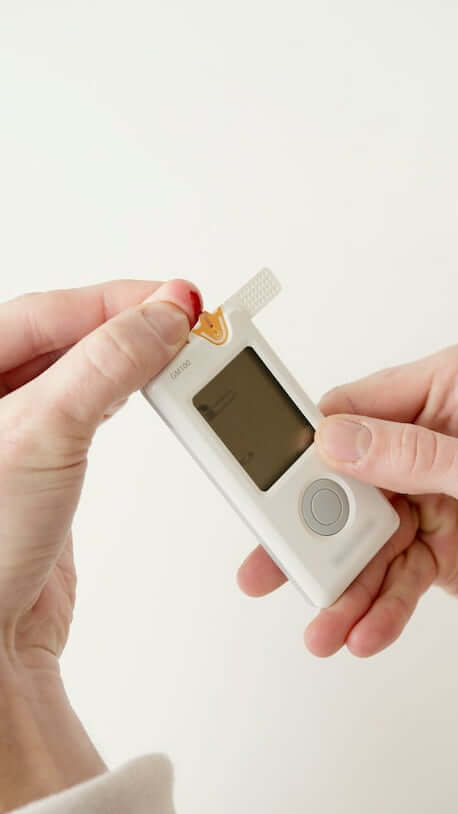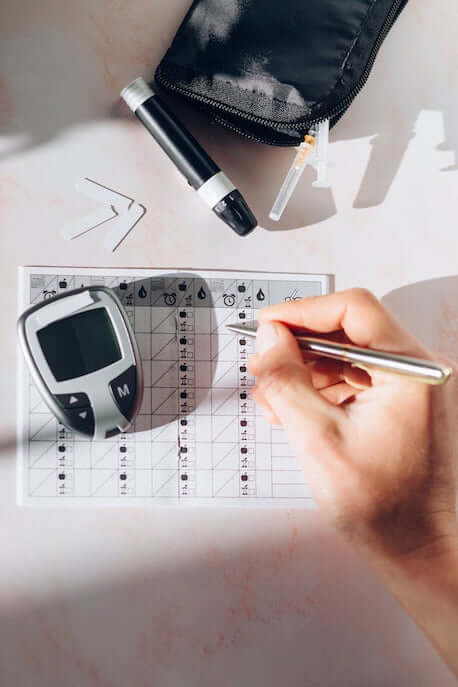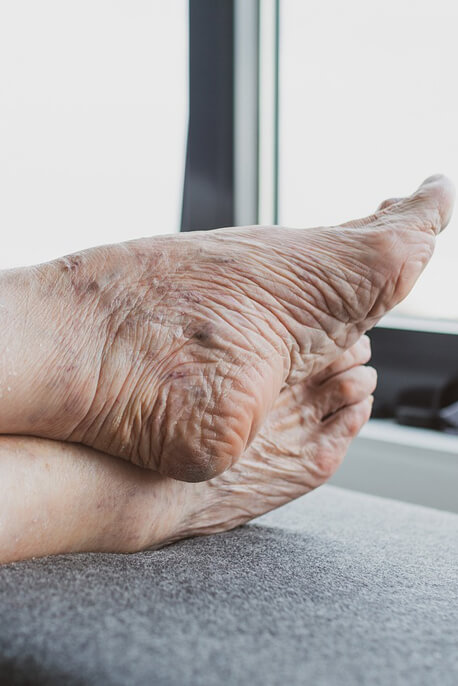Diabetic Nerve Pain Treatment in Sioux Falls
If you’ve recently been diagnosed with diabetes or are feeling the effects of diabetic nerve damage, you probably have questions. What causes diabetic nerve pain? Is it curable? What can I expect to experience daily? What treatments are available for nerve damage?
We at Axiom Chiropractic & Neuropathy understand your concerns and want to reassure you that recovery is possible and symptom relief is well within reach.
What Is Diabetic Neuropathy?
Your brain sends messages to the rest of your body via a vast network of nerves. Nerves collect data about the things you are experiencing: pressure, vibration, temperature, pain, etc. The nerves then send that information back to the brain, which deciphers the information and decides the next action. Like all bodily systems, your nerve network thrives under certain conditions and doesn’t do well in others.
People with diabetes don’t have enough insulin to shuttle blood sugars into the cells to use as energy. Either their pancreas does not produce adequate amounts of insulin (Type 1 Diabetes), or they’ve developed metabolic resistance, and their body needs more than average insulin levels to accomplish the same goal (Type 2 Diabetes).
Nerve damage in areas of the body other than the brain or spine is called peripheral neuropathy. Elevated blood sugar and insulin create an internal environment that, over time, can damage nerves throughout the body, especially in the hands and feet. Neuropathy pain is caused by damaged nerves sending corrupted signals to the brain that get interpreted as itching, burning, stabbing, heat, cold, or numbness.

Is Diabetic Neuropathy Dangerous?
Nerve pain from diabetic neuropathy itself is not dangerous. However, it can cause discomfort from pain signals that can be mild or intense and can also come and go depending on external and internal environmental factors.
While this discomfort alone may not be dangerous, diabetic neuropathy can lead to a number of unpleasant side effects that could pose risks. These risks include:

Masking: As nerves send corrupted signals, or signals are interrupted due to permanent nerve damage, the nerves may miss cues that you’ve been injured. You could step on a piece of glass and never feel it.
Infection: Another side effect of diabetes is restricted blood flow to the extremities. That means the healing process is slow. You could develop infections that lead to blood poisoning, gangrene, amputation, and death. Those with peripheral neuropathy need to exercise constant vigilance and go to the hospital when wounds aren’t healing well or quickly enough. (Check your feet daily to be safe.)
Balance Problems: Nerves help the body move. They tell your brain that your foot is on the floor or lifted. They signal that there are obstacles in your path. People with neuropathy often experience poor balance and poor reaction times when they trip, leading to nasty falls and injury. You may need a cane or walker to move around and avoid injury.
Sleep Deprivation: A common complaint among patients with diabetic neuropathy is that the nerve pain in their feet is so severe that even the weight of a bedsheet is too painful. As a result, their sleep suffers. Repeated nights without sleep can cause difficulties driving and working. It also makes you irritable and less able to cope with life’s challenges. Unfortunately, lack of sleep worsens nerve pain, which becomes a cyclical problem.
Inability to Live Independently: Advanced neuropathy patients can find routine daily tasks difficult. Little things like buttoning their shirts, gripping objects, feeling their foot on the gas and brake pedal, and more can become too difficult to do independently. They may find themselves unable to live without assistance.
What Causes Diabetic Nerve Damage?
With diabetic neuropathy, nerve damage develops when the patient can’t control their blood sugar levels. Like all organic tissue in your body, nerves need a constant supply of nutrients and oxygen to survive.
Sugar in the form of glucose is necessary for many organs. It isn’t good for blood vessels, oxidizing them similar to the way that salt corrodes metal. Your body creates antioxidants to combat this problem, but elevated glucose levels damage blood vessels faster than the antioxidants can repair them.
Insulin is a delivery system that allows glucose into the cell walls to be used as energy. If you don’t produce enough insulin, or have high levels of insulin for a long time, your body could grow resistant to it. As a result, glucose can’t enter the cell walls and circulate in the blood. Over time, veins and arteries will become damaged.
You’ll first experience nerve damage in your feet and hands because the capillaries are small, so they are more easily damaged. The tiny vessels quit feeding the nerves and surrounding tissues over time. The tissues get weaker and more damaged until they die without diabetic nerve pain treatment. Left untreated, the tissue dies (known as becoming necrotic) and must be amputated to prevent infection.

Is Diabetic Neuropathy Pain Curable?
Yes and no. Neuropathy, in many cases, is progressive. Type 2 diabetes, often brought on by lifestyle (eating an overabundance of simple carbs until the insulin quits working properly) or pregnancy, can improve with early diabetic neuropathy treatment. Treating the underlying cause before the damage is permanent creates an internal environment conducive to healing.
Type 1 diabetes, on the other hand, is a congenital condition and incurable, but nerve pain can be mitigated by keeping blood sugars and insulin levels on point. In the proper balance, inflammation goes down, blood vessels deliver nourishment and oxygen, and nerves can heal if they aren’t too damaged, but that healing lasts only as long as the diabetes is under control.

Things To Understand As You Seek Diabetic Neuropathy Treatment In Sioux Falls:
Diagnosis
A doctor can diagnose you by getting a thorough medical history and performing a physical examination, blood tests to rule out infection or nutritional deficiencies, and sometimes genetic tests for inherited disease.
Treatment
Traditional diabetic nerve pain treatment in Sioux Falls focuses first on lifestyle adjustments.
- Quit Smoking: Nicotine constricts blood vessels, which starve nerves of needed nutrients and oxygen.
- Get Your Blood Sugar Under Control: By closely regulating blood sugar levels, damage caused by elevated glucose can start to heal.
- Be More Active: Exercise increases blood oxygenation and circulation, improving peripheral nerve health and function.
Prescription pain relief medications come next. Unfortunately, drugs designed to control pain don’t address the reason damage occurs, so they can’t fix the underlying problem. They only mask the symptoms. Another problem with drugs is that the types of drugs used to deal with nerve pain can interact negatively with other medications and cause some disturbing side effects. Side effects could include any of the following:
Anti-seizure drugs.
- Pregabalin (Lyrica).
Side effects: weight gain, dry mouth, drowsiness, dizziness, constipation, difficulty concentrating, confusion, respiratory depression, agitation, anger, depression, fear, and violence. - Gabapentin (Gralise, Neurontin)
Side effects: clumsiness, mood changes, drowsiness, continuous uncontrollable eye movements, black and tarry stools, chills, cough, fever, chest pain, memory loss, pain and swelling in arms and legs, sore throat, sores in the mouth, unusual bleeding, difficulty urinating.
Antidepressants.
- Amitriptyline
Side effects: nausea, vomiting, weakness, drowsiness, nightmares, headache, dry mouth, difficulty urinating, constipation, blurred vision, burning or tingling in hands and feet, excessive sweating, weight gain, confusion, changes in sex drive or ability, unsteadiness. - Nortriptyline (Pamelor)
Side effects: increased risk for heart attack or stroke, agitation, cold sweats, blurred vision, confusion, chest pain, tinnitus, dizziness, pounding or irregular heartbeat, hallucinations, difficulty urinating, paranoia, hostility, inability to move or speak, labored breathing, loss of balance, loss of consciousness, uncontrolled muscle movement, panic, redness in the face, neck, chest and arms, slurred speech, sores in the mouth, seizures, swollen lymph glands. - Desipramine (Norpramin).
Side effects: stomach pain, nausea, vomiting, cough, blurred vision, confusion, convulsions, dizziness, racing heartbeat, inability to move or speak, anxiety, loss of appetite, incontinence, uncontrolled muscle movement, hallucinations, unsteady walking, restlessness, nightmares, rash, fever, loss of coordination, sweating, swelling, yellow eyes and skin.
Serotonin and norepinephrine reuptake inhibitors (SNRIs)
- Duloxetine (Cymbalta, Drizalma Sprinkle)
Side effects: Area rash, blindness, blisters or peeling skin, blurred vision, chest pain, cold sweat, confusion, difficulty swallowing, dizziness, fainting, racing heartbeat, weakness, thirst, decreased urine output, joint and muscle pain, red skin lesions, hive-like swelling (of the face, tongue, throat, extremities, or sex organs), bad breath, vomiting blood, yellow eyes and skin. - Venlafaxine (Effexor XR).
Side effects: Problems ejaculating, decreased sex drive, inability to orgasm, impotence, weakness, headache, blurred vision, chest pain, irregular heartbeat, tinnitus, mood changes, suicidal thoughts, lightheadedness, incontinence, rash.
The bandage approach of medicating can cause more problems than you had before you started popping pills. That’s why our focus is finding the root of the problem rather than masking the symptoms with potentially harmful substances.
Our Approach
Axiom Chiropractic & Neuropathy provides diabetic nerve pain treatment in Sioux Falls and is committed to finding healthy solutions for every client. We don’t cover up the problem. We don’t treat it with medications that can be as harmful as the problem itself. We get to the root of the problem for lasting results without side effects.
While we can’t bring dead nerves back to life, we can help you create an internal environment conducive to healing. It is much like looking at a sick plant. The plant will heal itself if you give it the proper amount of water, sunlight, nutrients, warmth, and fresh air. Consequently, we focus on:

- Investigation: We thoroughly investigate the root cause(s), as you can have more than one cause. In addition to elevated blood glucose levels, you may have a vitamin deficiency or take a medication that causes nerve damage. We don’t believe in cookie-cutter solutions. Every patient has unique challenges, and that requires personalized solutions.
- Custom Treatment Plans: We tailor the plan to meet individual needs, including:
- Innovative Technology: We use several different customized treatment modalities that come together to treat the root of the problem for lasting results. The latest innovations in technology maximize your body’s healing potential. Our focus is on increasing blood flow, improving oxygenation, minimizing the impact of diabetes, and improving nerve regeneration and conductivity.
- Nutrition counseling. A diet with high antioxidant content, whole fruits and vegetables, lean meats, and whole grains decreases inflammation, lowers blood glucose levels, and helps repair oxidized blood vessels.
- Individualized workouts: We provide exercises that consider your strengths and challenges. These exercises increase blood flow in the affected areas, ensuring adequate nutrition and oxygen flow to the damaged nerves. Exercise can also help keep blood sugar levels in check, improve overall mood, and relieve muscle tension that may compress nerves.
- Easy On Your Budget and Schedule: We’re conscious of your budget as well as how busy your life can be. That is why, for certain patients, we offer treatment options that do not require you to come into the office. Instead, patients can perform therapies from the comfort of their own homes. That means less time in the car, less gas used, and less hassle. We focus on helping you achieve wellness in the most efficient, ethical, and economical way possible.
Last Thoughts
Nerves are tiny, delicate instruments that can significantly impact your quality of life. As discouraging as it can be to suffer pain, burning, tingling, and pins and needles in your hands and feet, there is hope. We know more about diabetic nerve pain than ever before in our history. And with that knowledge comes tools and techniques that can create a healthy, healing internal environment for lasting neuropathy relief.
If you or a loved one has been diagnosed with diabetic neuropathy, look for a “diabetic nerve pain treatment near me” as soon as possible. When dealing with progressive nerve damage, the sooner you seek treatment, the better to stop further damage and start the healing process before nerve damage becomes permanent. If you live in our area, search “diabetic nerve treatment near me in Sioux Falls” or call us at (605) 275-2010 to make an appointment.
DISCLAIMER: THIS ARTICLE DOES NOT PROVIDE MEDICAL ADVICE
The information, including but not limited to, texts, graphics, images, and other material contained in this article are for informational purposes only. None of the material mentioned is intended to be a substitute for professional medical advice, diagnosis, or treatment. Always seek the advice of your physician or other qualified healthcare provider with any questions you may have regarding a medical condition or treatment and before undertaking a new care regimen. Never disregard professional medical advice or delay in seeking it because of something you have read in this article.
